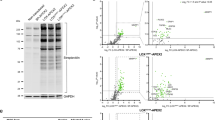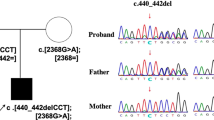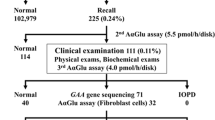Review of the analytical and clinical validity as well as of the clinical utility of DNA-based testing for mutations in PGM3 in diagnostic, predictive and prenatal settings, and for risk assessment in relatives.
Similar content being viewed by others
1. DISEASE CHARACTERISTICS
1.1 Name of the disease (synonyms)
Deficiency of N-acetylglucosamine-phosphate mutase 1, AGM1 deficiency, deficiency of phosphoglucomutase 3, PGM3 deficiency, PGM3-CDG, immunodeficiency 23.
1.2 OMIM# of the disease
615816.
1.3 Name of the analysed gene or DNA/chromosome Segments
PGM3.
1.4 OMIM# of the gene
172100.
1.5 Mutational spectrum
At least sixteen variants have been reported: ten missense variants, three deletion variants, a duplication variant and two splice variants (www.lovd.nl/PGM3). One patient showed a missense variant and on the other allele a deletion of several genes comprising the whole PGM3 gene. The standard reference sequence indicating reported variants (ENSG00000013375) and a reference for exon numbering (ENST00000513973.5) can be found at http://www.ensembl.org.
1.6 Analytical methods
Sanger sequencing of the 12 coding exons and flanking intronic sequences of the PGM3 gene (NCBI reference sequence: NM_015599.3).
1.7 Analytical validation
Sanger sequencing identifies variants in >99% of patients. Deep intronic variants, large deletions and duplications would not be detected using this approach.
1.8 Estimated frequency of the disease
(Incidence at birth (“birth prevalence”) or population prevalence. If known to be variable between ethnic groups, please report):
At least thirty-eight genetically confirmed patients (from 16 families) have been reported [1,2,3,4,5,6,7,8,9]. The frequency and the prevalence of the disease are not known.
1.9 Diagnostic setting
Yes. | No. | |
A. (Differential) diagnostics | ⊠ | |
B. Predictive Testing | ⊠ | |
C. Risk assessment in relatives | ⊠ | ☐ |
D. Prenatal | ⊠ | ☐ |
Comment: Deficiency of phosphoglucomutase 3 (PGM3) is an autosomal recessive disorder of N- and O-glycosylation, first reported in 2014 [1,2,3,4]. PGM3, a cytosolic enzyme, catalyzes the reversible conversionof N-acetylglucosamine-6-phosphate into N-acetylglucosamine-1-phosphate, required for the synthesis of UDP-GlcNAc. This hexosamine is used to assemble N-glycans, O-glycans, proteoglycans, and glycolipids. PGM3-CDG is one of the some 130 known congenital disorders of glycosylation (CDG), genetic defects in protein and lipid glycosylation and in the synthesis of glycosylphosphatidylinositol (GPI) anchors. Most CDG are multisystem disorders with prominent neurological involvement. They show a great clinical heterogeneity.
PGM3-CDG is a multisystem disorder with predominant immunological involvement. The majority of the patients showed recurrent infections (skin, ears, lungs, gastrointestinal system; mainly S. aureus infections, candidiasis and viral infections), atopic disease (eczema, asthma, multiple allergies), psychomotor disability, failure to thrive, skeletal abnormalities (skeletal dysplasia, scoliosis, brachydactyly), eosinophilia, serum hyper-IgE and decreased CD4 T-cells. Symptoms/signs present in a minority of patients were mainly: facial dysmorphism, short stature, auto-immunity, splenomegaly, neurological problems (hypotonia, ataxia, dysarthria), lung abnormalities (respiratory insufficiency, bronchiectasis), gastrointestinal problems (reflux disease, obstruction, malrotation), renal problems (horseshoe kidney, hydronephrosis), other haematological abnormalities (bone marrow failure, anemia, thrombocytopenia, variable changes in leukocytes), and variable changes in serum IgA, IgG and IgM. Survival ranged from 5 days to over 60 years. Patients have been reported from Africa, Central and North America, Asia and Europe. Current screening tests for defects in N- and O-glycosylation (mainly serum transferrin and apo C-III isoelectrofocusing) show normal results. The diagnosis of PGM3-CDG is based on the clinical acumen of the physician and confirmed by mutation analysis of PGM3. Identification of the pathogenic variant(s) will permit heterozygote detection in the family, and prenatal diagnosis.
2. TEST CHARACTERISTICS
Test | Genotype or disease | A: True positives | C: False negative | |
Present | Absent | B: False positives | D: True negative | |
Positive | A | B | Sensitivity: Specificity: | A/(A+C) D/(D+B) |
Negative | C | D | Positive predictive value: Negative. predictive value: | A/(A+B) D/(C+D) |
2.1 Analytical sensitivity
(Proportion of positive tests if the genotype is present).
Not applicable since there is no test available.
2.2 Analytical specificity
(Proportion of negative tests if the genotype is not present).
See section 2.1.
2.3 Clinical sensitivity
(Proportion of positive tests if the disease is present).
The clinical sensitivity can be dependent on variable factors such as age or family history. In such cases a general statement should be given, even if a quantification can only be made case by case.
See section 2.1.
2.4 Clinical specificity
(Proportion of negative tests if the disease is not present).
The clinical specificity can be dependent on variable factors such as age or family history. In such cases a general statement should be given, even if a quantification can only be made case by case.
See section 2.1.
2.5 Positive clinical predictive value
(Life time risk to develop the disease if the test is positive).
See Section 2.1.
2.6 Negative clinical predictive value
(Probability not to develop the disease if the test is negative).
Assume an increased risk based on family history for a non-affected person. Allelic and locus heterogeneity may need to be considered.
Index case in that family had been tested:
See section 2.1.
Index case in that family had not been tested:
See section 2.1.
3. CLINICAL UTILITY
3.1 (Differential) diagnostics: The tested person is clinically affected
(To be answered if in 1.9 ‘A’ was marked).
3.1.1 Can a diagnosis be made other than through a genetic test?
No. | ⊠ (continue with 3.1.4) | |
Yes, | ||
Clinically | ☐ | |
Imaging | ☐ | |
Endoscopy | ☐ | |
Biochemistry | ☐ | |
Electrophysiology | ☐ | |
Other (please describe) | ||
3.1.2 Describe the burden of alternative diagnostic methods to the patient
Not applicable.
3.1.3 How is the cost effectiveness of alternative diagnostic methods to be judged?
Not applicable.
3.1.4 Will disease management be influenced by the result of a genetic test?
No. | ☐ | |
Yes. | ⊠ | |
Therapy (please describe) | Symptomatic treatment consists of antibiotic administration and immunoglobulin substitution. | |
One patient received at 4 months a hematopoietic stem cell transplant with cord blood. After 6 months, leucocytosis had normalized and there were no more infections. Another patient received at 6 months of age a bone marrow transplantation. This was followed by resolution of his neutropenia and lymphocyte function [3]. No long-term follow-up is available. | ||
Prognosis (please describe) | Molecular testing is essential for confirmation of the diagnosis and genetic counselling of the families concerned. | |
Management (please describe) | PGM3-CDG is a multi-system disease, mainly involving the immune system, the skeleton and the brain. Follow-up by a multidisciplinary team is mandatory. |
3.2 Predictive Setting: The tested person is clinically unaffected but carries an increased risk based on family history
(To be answered if in 1.9 ‘B’ was marked).
3.2.1 Will the result of a genetic test influence lifestyle and prevention?
If the test result is positive (please describe):
Not applicable.
If the test result is negative (please describe):
Not applicable.
3.2.2 Which options in view of lifestyle and prevention does a person at-risk have if no genetic test has been done (please describe)?
Not applicable
3.3 Genetic risk assessment in family members of a diseased person
(To be answered if in 1.9 ‘C’ was marked).
3.3.1 Does the result of a genetic test resolve the genetic situation in that family?
Usually yes, by testing the potential heterozygous persons (carriers) in the family.
3.3.2 Can a genetic test in the index patient save genetic or other tests in family members?
No.
3.3.3 Does a positive genetic test result in the index patient enable a predictive test in a family member?
Not applicable.
3.4 Prenatal diagnosis
(To be answered if in 1.9 ‘D’ was marked).
3.4.1 Does a positive genetic test result in the index patient enable a prenatal diagnosis?
Yes. Prenatal diagnosis should be performed by molecular analysis.
4. IF APPLICABLE, FURTHER CONSEQUENCES OF TESTING
Please assume that the result of a genetic test has no immediate medical consequences. Is there any evidence that a genetic test is nevertheless useful for the patient or his/her relatives? (Please describe)
Knowledge of the diagnosis will stop unnecessary further investigations, will help patients and parents of affected children in the process of accepting the disease and will make possible to consider treatment options.
References
Moens LN, Falk-Sörqvist E, Asplund AC, Bernatowska E, Smith CIE, Nilsson M: Diagnostics of primary immunodeficiency diseases: a sequencing capture approach. PLoS ONE 2014. https://doi.org/10.1371/journal.pone.0114901.
Sassi A, Lazaroski S, Wu G, Haslam SM, Fliegauf M, Mellouli F., et al. Hypomorphic homozygous mutations in phosphoglucomutase 3 (PGM3) impair immunity and increase serum IgE levels. J Allergy Clin Immunol. 2014;133:1410–9.
Stray-Pedersen A, Backe PH, Sorte HS, Mørkrid L, Chokshi NY, Erichsen HC., et al. PGM3 mutations cause a congenital disorder of glycosylation with severe immunodeficiency and skeletal dysplasia. Am J Hum Genet. 2014;95:96–107.
Zhang Y, Yu X, Ichikawa M, Lyons JJ, Datta S, Lamborn IT., et al. Autosomal recessive phosphoglucomutase 3 (PGM3) mutations link glycosylation defects to atopy, immune deficiency, autoimmunity, and neurocognitive impairment. J Allergy Clin Immunol. 2014;133:1400–9.
Bernth-Jensen JM, Holm M, Christiansen M. Neonatal-onset T−B−NK+ severe combined immunodeficiency and neutropenia caused by mutated phosphoglucomutase 3. J Allergy Clin Immunol. 2015;137:321–4.
Lundin KE, Hamasy A, Backe PH, Moens LN, Falk-Sörqvist E, Elgstøen KB., et al. Susceptibility to infections, without concomitant hyper-IgE, reported in 1976, is caused by hypomorphic mutation in the phosphoglucomutase 3 (PGM3) gene. Clin Immunol. 2015;161:366–72.
Ben-Khemis L, Mekki N, Ben-Mustapha I, Rouault K, Mellouli F, Khemiri M., et al. A founder mutation underlies a severe form of phosphoglucomutase 3 (PGM3) deficiency in Tunisian patients. Mol Immunol. 2017;90:57–63.
Pacheco-Cuéllar G, Gauthier J, Désilets V, Lachance C, Lemire-Girard M, Rypens F., et al. A novel PGM3 mutation is associated with a severe phenotype of bone marrow failure, severe combined immunodeficiency, skeletal dysplasia, and congenital malformations. J Bone Min Res. 2017;32:1853–9.
Lundin KE, Wang Q, Hamasy A, Marits P, Uzunel M, Wirta V, et al. Eleven percent intact PGM3 in a severely immunodeficient patient with a novel splice-site mutation, a case report. BMC Pediatr 2018. https://doi.org/10.1186/s12887-018-1258-9
Acknowledgements
This work was supported by EuroGentest2 (Unit 2: “Genetic testing as part of health care”), a Coordination Action under FP7 (Grant Agreement Number 261469) and the European Society of Human Genetics.
Author information
Authors and Affiliations
Corresponding author
Ethics declarations
Conflict of interest
The authors declare that they have no conflict of interest.
Additional information
Publisher’s note: Springer Nature remains neutral with regard to jurisdictional claims in published maps and institutional affiliations.
Rights and permissions
About this article
Cite this article
Jaeken, J., Lefeber, D.J. & Matthijs, G. Clinical Utility Gene Card for: PGM3 defective congenital disorder of glycosylation. Eur J Hum Genet 27, 1757–1760 (2019). https://doi.org/10.1038/s41431-019-0453-y
Received:
Revised:
Accepted:
Published:
Issue Date:
DOI: https://doi.org/10.1038/s41431-019-0453-y
This article is cited by
-
Epidemiology of congenital disorders of glycosylation (CDG)—overview and perspectives
Journal of Rare Diseases (2022)



